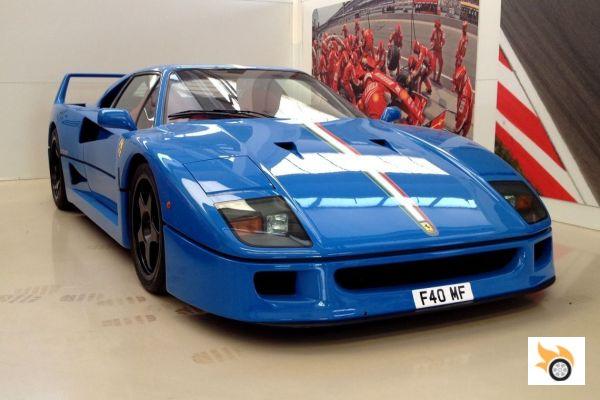We will now explain in more detail the origin and development of this model.
Starting point, 288 GTO (1984)
We entered the time machine and we came out in 1982 with shoulder pads and backcombed hair, when the Group B rally car appeared. For several years they were the kings of the curves, it was a spectacle to see them in motion given their power and speed. The Fédération Internationele du Sport Automobile announced that it was going to create a new GT category with the same rules as the Group B. Manufacturers wishing to compete had to compete in the GT category. Manufacturers wishing to compete had to build at least 200 units of the car they wanted to participate in order to homologate it.
The engine, if it was naturally aspirated, had to be less than 4,000 cc. In case of using turbo, the effective displacement would be the actual displacement by 1.4, so for these engines the figure had to be less than 2,857 cc. Both Porsche and Ferrari wanted to participate in this competition. With these premises, Ferrari was based on the 308 GTB, a small coupe with rear mid-engine. Its displacement was reduced and two turbos were added. The chassis also underwent several modifications. The engine bay was lengthened to accommodate it in longitudinal position, in addition to the new turbos and intercoolers.
The wheelbase was also lengthened and the wheel arches widened. The structure was tubular and used Kevlar -it was the first car to use it-, aluminum and nomex in some panels to lighten its weight. The suspension was the traditional Ferrari one: superimposed triangles. What changed the least was the style, Leonardo Fioravanti was very continuist with his successful 308, whose particular wedge line was born with the 365 GT4 BB, in turn derived from the Ferrari Pininfarina P6, of the same author. It is the typical Ferrari image of the 70s and 80s. The line is very compact with the nose elongated and very sharp with retractable headlights.
The wheels were five-spoke star, the rear lights round and the rear window was vertical just where the passenger compartment ends, leaving all the ventilation to the engine, the real protagonist of these cars. The side air intakes are very marked, the rest of the inlets and outlets are hidden with grilles. A black painted slit runs along the longest part of the side, lightening its weight and giving it more dynamism. In photos it can be difficult to distinguish the GTO from the 308, but live you can see the difference in width and length.
There are several details of the GTO that help us to distinguish it: the widened wheel arches -the front ones with the scudetto- that give it a Coca-Cola bottle look, four headlights on the front apron, a higher rear spoiler and some gills behind the rear wheels. These gills are reminiscent of the 250 GTO, from which it inherits its name and which indicate the rear position of the engine, we will also see them on the F40.
The interior had all the luxury of the time, leather, electric windows and air conditioning. As for the engine, it was finally a 2855 cc V8 with four valves per cylinder and two IHI turbochargers at 0.9 bar. The electronics were derived from F1. It finally produced 400 hp, with heart-stopping performance at the time: acceleration from 0-100 km / h in 5.9 s, 0-1,000 m in 21.7 s and 305 km / h top speed, being the first car to pass 300 km / h.
It was presented at the 1984 Geneva Motor Show under the name of Ferrari GTO -we usually call it 288 GTO to differentiate it from the 250 GTO and the 599 GTO-. When it was presented at the show, the 200 units required for homologation were already sold. Seventy-two more were built for special customers and were quickly sold. The last unit was built for Niki Lauda, who was finally making peace with Enzo. All went well for the GTO until 1986, when the Group B was banned due to its dangerousness - it is said that these cars were too fast to drive - so the future GT class was never raced.
When the competition was cancelled, the purpose of the car was no longer meaningful. On the other hand, as a passenger car it was eclipsed by the Porsche 959 that was presented in the same year, with 50 more HP and a higher top speed: 317 km/h, so it also lost its record. Ferrari took note of the experience and drew three conclusions: not to register any car until it was clear about the success of the competition, that Porsche was its greatest enemy and that it could sell any limited series. Although the F40 left him in the background, today it is a very sought after piece, whose price can vary from 1.5 to 3 million euros, depending on the state of the unit.
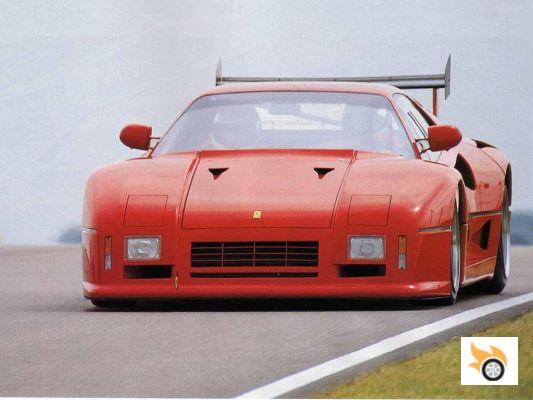
Ferrari 288 GTO Evoluzione (1985)
While the cars were being delivered to customers, Ferrari developed the GTO for its original purpose: racing. The company Michelotto Automobili - a Ferrari dealer in Padua in 1969 that later specialized in racing - was involved in the project. The aim was to make it the ultimate racing machine. To achieve this, the entire chassis, which was made of steel tubes, was revised, reinforced, lightened and its centre of gravity improved.
More composites were used than in the street model, using kevlar and carbon fiber. This material was glued to the steel tubes, something very strange at the time, even doubted if it would hold. The rigidity of the chassis increased by 20% - achieving three times that of a normal car - and the weight of the car dropped from 1,160 kg to 940 kg. To achieve this weight reduction, everything that was not essential was eliminated: the composite material was left in the air, the leather disappeared in favour of a simple felt, the seats became bucket seats with five-point harnesses and only the glass in the windshield was kept, the rest of the windows were made of plexiglass, with a side sliding window.
The engine was also revised and the turbos were changed for bigger ones, reaching 640 hp. The top speed was increased to 370 km/h, thanks in part to the new aerodynamics. The GTO's sharp shape became smooth cornering, with a prominent rear wing to improve cornering. Few things were retained from the GTO's look, just the side air intakes, horizontal line and rear gills. Everything else changed: the nose was more rounded, starting lower and ending abruptly before reaching the doors. The C-pillar dropped much more smoothly and with more volume.
The engine was protected from view by a plexiglass window, it was pierced, as was the entire rear, to allow ventilation of the engine and intercoolers. In short, a good work of engineering, whose appearance was spectacular and eminently of competition, but without interest in its design. There was no uniformity in its line, it mixed lines with curves, the air intakes appeared where they were needed, with no apparent order. This competition model was the one cancelled by the disappearance of Group B, it had no chance to compete.
However, this development was not forgotten, it was the starting point of the car we are interested in, the Ferrari F40. Only six units of this model were built, although the first one was actually a modification of a GTO. Despite being a vehicle only for circuit, it is a very sought after model, given its small number.
Ferrari F40 (1987)
It was 1986, with no major Ferrari racing successes, with Group B cancelled and the Ferrari GTO as the first of the slowest cars in the world. Pissed off by the situation, Enzo with his fist banging on the table - I imagine - commissioned the development of the car that was to show the whole world that, despite everything, Ferrari was still Ferrari. They had to create a new GT Omologato, with which they could go to work from Monday to Friday and race on Sunday, with all the Ferrari know-how, applying the latest F1 techniques, it had to be made for pure driving, no luxuries. For what competition, for nothing, for the pleasure of driving.
And it had to be beautiful, very beautiful and the fastest car of the moment, Enzo's dream. What the marketing department would later tell Autocar at its presentation was that it was a car for pure performance enthusiasts, not a laboratory for the future, as the 959 was. Ferrari was not Star Wars. Finally, they added that it would have been created whether the 959 existed or not.
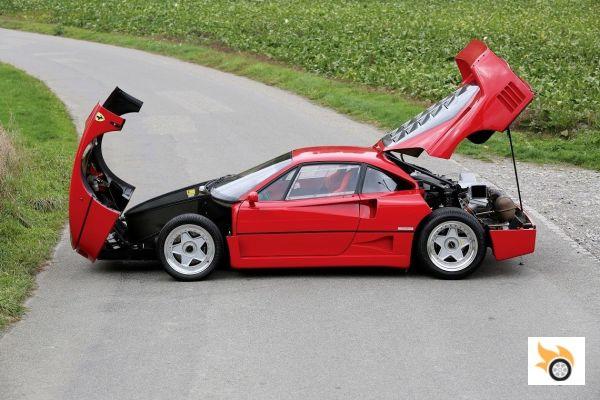
Chassis and engine
Of course, it was based on the GTO Evoluzione, which was increased in displacement to 2,936 cc and tamed a little by lowering the power to 478 hp; among other things, the size of the turbochargers was reduced so that, although it produced less power, it was a little more progressive. The rest was maintained: V8 at 90º, 4 valves per cylinder, double injector per cylinder, one ignition coil for every two cylinders and two IHI turbos at 1.1 bar. The engine layout was longitudinal rear and the gearbox was five-speed.
It is curious that it had two CPUs for its management, one for each bank. The suspension layout was maintained and also its height was adjustable in three positions. The interior remained the same as the Evoluzione, not a single luxury, neither now nor then. The composite material was exposed and unprotected, a textile lining covered the dashboard and console. The seats were racing seats covered by a thin layer of padding, whose only adjustment was three positions and needed some tools to change them.
What about the doors? They lacked trim, as a handle they had a hanging cable and their windows were impracticable in the first 50 units, they only had a sliding sheet equal to the one of the Evo. The only interior equipment was the air conditioning, essential if we drive with fireproof overalls, because of the heat given off by the engine. There was no glove box, no leather, no radio, not even soundproofing, none of this is useful to go faster. There was also the gearbox grille, typical in Ferrari, and the pedals were simply drilled aluminum.
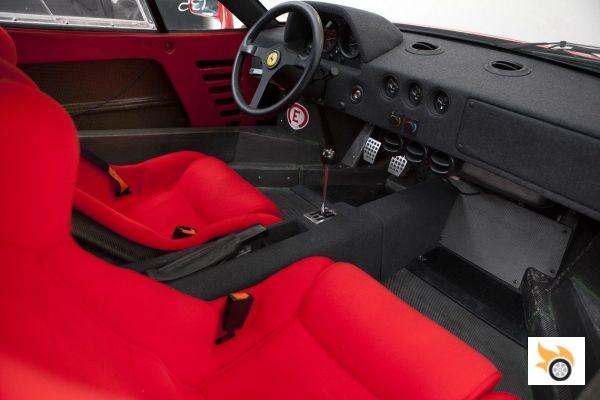
The interior, dominated by the clocks, was as spartan as it was irresistible, as it screams to the winds that this is a racing Ferrari. A detail of its interior, which has been inherited by the following generations, is the start button, the key only gives the contact to the electric circuit. As for the mechanical equipment was the same, it is not that it had no traction control or ABS, is that it had no power steering or brake servo. That is not necessary to have a good time on the circuit, so there is no intermediary between us and our car, everything is as direct as possible.
The weight was 1.100 Kg -what a current B weighs- for 478 HP, which leaves a weight/power ratio of 2,3 Kg/HP, bestial even for today. The engine's behaviour was that of the old school turbos, with a kick at 3,000 revs. Up to these revs the engine is rather docile, when it reaches 3,000 it practically jumps to 3,500 immediately. As for the dimensions are in a battle of 2,450 mm, with a length of 4,358 mm, the width of 1,970 mm and a height of 1,124 mm.
The tyres were of record with a big difference between axles: Pirelli P Zero, 245/40 VR17 at the front and 335/35 VR17 at the rear. Enzo finally achieved his dream, he built the fastest car of the moment, with a top speed of 324 km/h or more than 200 miles/hour, a record he held until the arrival of the Bugatti EB110 in 1992. Acceleration from 0-100 km/h was 4.1 s, somewhat worse than that of the Porsche 959 with four-wheel drive. The kilometre with a stationary start was done in 20.9 seconds. To give you an idea, although it was soon surpassed by other supercars, in pure performance it still surpasses the current M3.
Even so, if you wanted more power, you could also order the supercharged version without catalytic converters that reached 650 hp, as did the Sultan of Brunei.
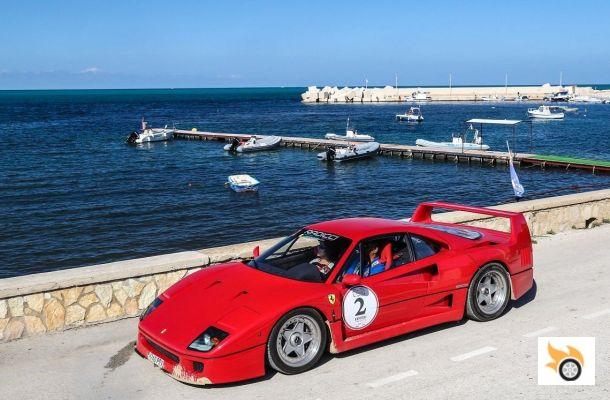
Design
Leonardo Fioravanti once again gave us a master class, showing us the difference between engineering and design. Now the car was a whole and not a collage of hatches, aerodynamic accessories and NACA type air intakes. By the way, these intakes were designed by the National Advisory Committee for Aeronautics -before they became NASA in 1958- to allow air to enter without generating vortices or increasing the aerodynamic drag coefficient.
The Evo's silhouette was retained, as were its proportions. The two large one-piece bonnets were also retained to facilitate access to the mechanicals. However, the lines were made purer by eliminating curves. The volumes became more rectangular, appearing a plane from the doors that reached the end of the car. The nose was flat and had two sets of headlights: the upper ones were retractable with the dipped and main beam lights and the lower set enclosed the turn signal and the long-range headlight behind a polycarbonate sheet. In the underbody, Ferrari recovers the lost "mouth".
From the beginning, Ferrari models had an oval radiator inlet, similar to a nozzle. From 1968 and with the entry of the wedge era with the 365 GTB4 or Daytona, this mouth was lost in favor of a small rectangular opening. The F40 now recovers that entrance, for the first time surrounded by composite material. The flat bonnet, polycarbonate-covered headlights integrated into it and two side vents for brake ventilation along with that entrance generate the image of Ferrari for many years.
As we said, this model is more rectangular, especially at the rear, dominated by a huge boxy spoiler, perhaps the most distinctive feature of the car. This spoiler doesn't seem to provide much support as it is very flat, in the racing versions it was adjustable. It seems to provide stability at high speed, because of the vertical planes they form. As for the aerodynamic coefficient is 0.34, not bad for the time, the problem was that the underbody was not fairing. On its right side has F40 in bas-relief so that we do not forget which car is the one we are admiring.
Another of the design details inherited by all Ferrari mid-engined cars to date is the transparent cover over the engine, something for which all fans are grateful. The exhausts had a curious configuration of three outlets that later paid homage to the 458 Italia. We can say that with this model Ferrari ended the wedge era and began the organic one. By the way, when Enzo saw the F40 for the first time he said "Bello, molto bello".
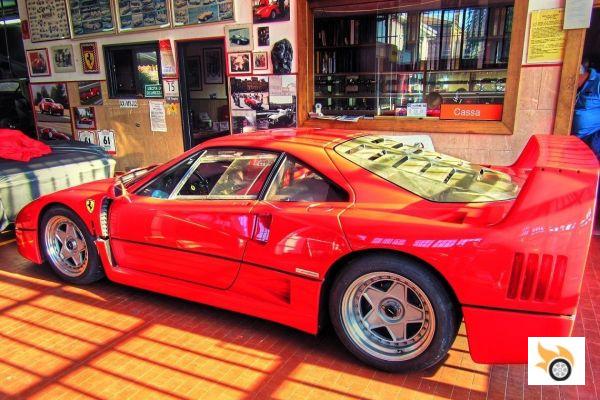
Production and sales
The F40 was presented directly by Enzo Ferrari at the Centro Civico in Maranello on July 21, 1987, 40 years after the presentation of the 125, hence the name of the car. After this presentation, 900 purchase requests were received. Initially a limited production run of 300-400 models was planned, but some 3,000 orders were received. The number of vehicles produced was 1,315 units. As the demand was much higher than the production, a condition was introduced: to have bought a Ferrari before.
These cars were purchased by pure driving enthusiasts, many of them were professional drivers, here we could mention almost the entire F1 team. One of these enthusiasts was Nick Mason, Pink Floyd's drummer. It is said that he lent his to Gordon Murray when he was developing the McLaren F1, from which he extracted the driving sensations, although in other interviews he stated that it was a great kart. Other buyers tried it the first day, got scared and left it in the garage, for this reason there are still some units with few kilometers of use.
From this group we can remember another illustrious Modenese, Luciano Pavarotti. He asked for one for singing in the concert of The Three Tenors. The Ferrari engineers said that why did he want it, as he was not going to fit behind the steering wheel. Although he drove it very little, he kept it proudly all his life. Finally, his widow put it up for sale and it was bought by a young German F1 driver named Vettel. There is a third group of buyers, even more special, because they asked for modified versions. Here we can remember the royal family of Brunei who ordered several units with overpowered right-hand drive.
On the other hand, Gianni Agnelli asked for one with automatic gearbox; the Mondial T was used and could disengage and engage the clutch in 100 ms. In addition to the road versions, ten more were produced for competition: the first two were called LM - after Le Mans - and the rest were called Competizione. At first glance we can differentiate them because they did not have retractable headlights, they had a larger opening in the bonnet and the rear wing was adjustable. It is also said that many of the sales were to speculate on its price because, in addition to its qualities as a car, it was the last car created under the supervision of Enzo Ferrari, as he would die a year later.
This creates a halo of exclusivity around it as the last model supervised by the Drake. In the Spanish market it appeared at a price of 39 million pesetas - 600,000 euros correcting for inflation - compared to 27 million pesetas for the Testarossa. Soon after, it was possible to find models for twice its factory price - the same as it happens today with LaFerrari - even a model appeared in the press for ten times its value.
Because of its sales and those of the Testarossa, Ferrari's cash box was full when Luca Cordero di Montezemolo arrived, with this cash he was able to relaunch the brand. The price of an F40 today starts at around 300,000 euros, considerably less than the previous models. This is because it was produced in larger numbers. If we want it with a Ferrari Clasiche certificate the price can go up to double. If the unit has few kilometers or a lot of history, it can go over a million euros.
F40 or 959?, the eternal doubt
We have already mentioned that the great competitor of the F40 was the Porsche 959, but which of these two models was the best? It is not easy to answer this question, because there is no clear answer, we must say: it depends and we are going to explain why. In 1988 Ferrari invited journalists to test the F40 at its private circuit in Fiorano. The question of the moment was, will the Ferrari F40 be better than the Porsche 959? To answer the question, both Car and AutoCar journalists went to the circuit with a 959 to find out; in Spain we saw AutoCar's test in Automóvil magazine.
First, let's briefly introduce the 959. Porsche built its own Group B model for the same GT championship that never took place. They also built more than the necessary for homologation: 337 units. It came to be a 911 with twin turbo and which was adjusted the displacement to 2850 cc and was the first 911 with water cooling. It was the most evolved car of its time, with technologies that are not common today. Of these technologies we highlight: ABS brakes, tire pressure monitoring, self-adjusting 4×4 traction and electronic height adjustment and suspension hardness, also had an ultra-short gear to get out of very slippery floors - yes, I'm thinking about it too, could tow a Cayenne.
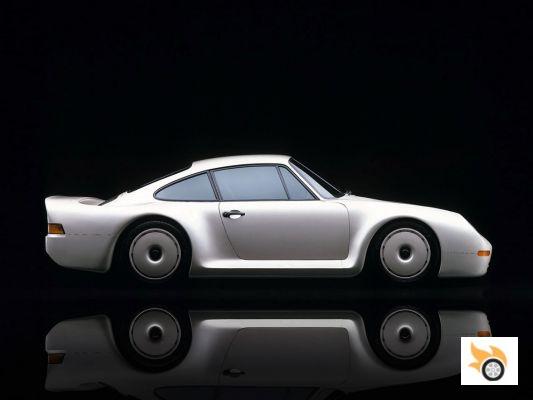
All this technology was designed so that any driver could control a 450 hp machine, able to go from 0 to 100 km/h in less than 4 seconds and comfortably pass the 300 km/h top speed. As for the aesthetics of the 959 is continuist with other 911. To differentiate it we must look at the more enveloping bumpers, with holes in the four corners to house as many radiators. Another difference is the side air intake, in front of the rear wheel; however, the most notable difference is the wraparound spoiler that extends the rear. As you can see, in its mechanical approach and use it is the opposite of the F40, even in its aesthetics: new for the Italian and conservative for the German.
In the Italian car the effectiveness in the circuit and the sensations at the wheel are the most important, in the German car the ease of driving in any circumstance is the most important. The testers of both models came to the same conclusion, they preferred the 959 for long trips and bad roads. On the track everything changes. The F40 is in the middle of the pack, the greater width and lower centre of gravity make it much more effective. Cornering is much quicker as it could brake later and accelerate earlier than the 959. At the Fiorano circuit the F40 was between 6 and 10 seconds per lap faster than the 959.
We have to say that the Italian car was tuned in this same circuit, even so, there is a huge difference. We already have an answer, the F40 is the winner on the track and the 959 for any road. As for aesthetics -always subjective- the winner is the Pininfarina model, it's a unique model, very well finished and it says on the outside what's on the inside. The 959 is a reinterpretation of the 911. In other words, among many Ferraris, the F40 still gets noticed, at a Porsche rally, the 959 would go almost unnoticed.
Current market
You can still find models for sale in various places, but if you're curious about something special - or several million - you can search for your favourite model on Talacrest. Mr Collins offers you several of them, including: 288 GTO, one with only 3.000 Km, and Chris Evans' one, painted in white. He also has a 288 GTO Evoluzione. Finally, if you like to race a classic of the eighties, you can do it with a 650 hp F40 ex Sultan of Brunei with 650 hp and yellow color that we have put in the picture.
In my case, I don't have that kind of money to buy and maintain such a machine, so at home we have a replica, specifically the one made by Lego. Of course it is not the most faithful, but it is very nice to build a F40 by hand, even if it is a block. A recommendation, if you think about buying it, do it as soon as possible, first because it is a limited series, secondly because the children are very quick and you run the risk of not participating in the assembly.
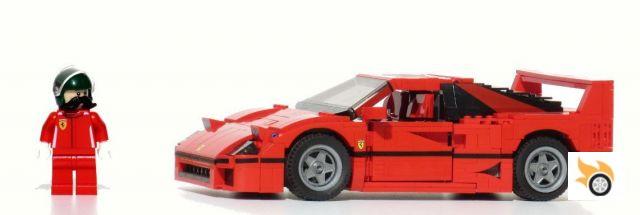
After 30 years this model is still captivating, both for its looks and for its pure driving philosophy. In terms of looks, it still looks like it has just come off the racetrack and gives the impression of being modern and aerodynamic. In terms of performance, the first model to beat it at home was the F50 in 1995. If we look at the times on the Fiorano circuit of more normal models, the F430, it does the same time as an F50 and both beat the F40 by 2.6secs. If we move on to the 458 Italia it beats it by 4.6s, with the recent 488 GTB being 6.6s quicker, doing a time of 1:23 compared to 1:29.6 for the F40.
This last model was criticized for being a turbo Ferrari, forgetting the models that we are remembering here and that have been so important for Ferrari. Now I'm going to play Morpheus and you are going to be Neo. In one hand I show you a key of a 488 GTB and in the other the key of a F40; I leave you only one of them, you can do the same with both cars. The first one has 670 hp, turbo with no lag, paddle shifter, driving aids and is 6s faster in Fiorano; the other one has 478 hp and no controls. Which key would you take?
